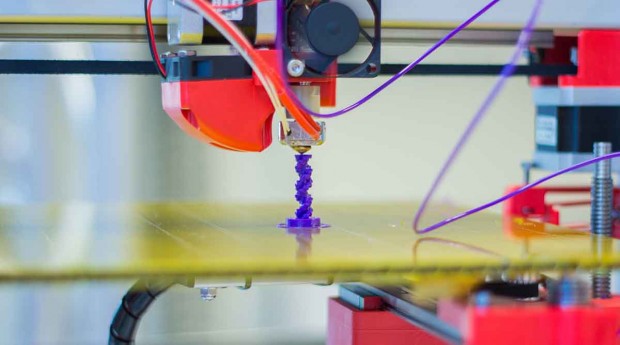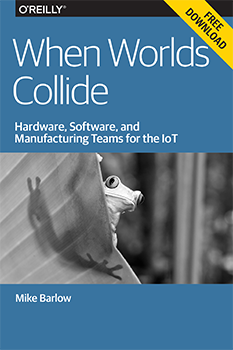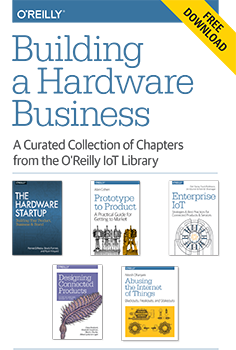"Every Company is a Software Company" entries

Signals from the O’Reilly 2015 Solid Conference
Insight and analysis on the Internet of Things and the new hardware movement.
Practitioners, entrepreneurs, academics, and analysts came together in San Francisco this week to discuss the Internet of Things and the new hardware movement at the O’Reilly 2015 Solid Conference. Below we’ve assembled notable keynotes and interviews from the event.
Lock in, lock out: DRM in the real world
Author and activist Cory Doctorow uses his Solid keynote to passionately explain how computers are already entwined in our lives and our bodies, which means laws that support lock-in are much more than inconveniences. Doctorow also discusses Apollo 1201, a project from the Electronic Frontier Foundation that aims to eradicate digital rights management (DRM).

Practical advice for hardware startups
Entering the hardware space is easier than ever. Succeeding is a different matter.

Because of recent innovations in prototyping, crowdfunding, marketing, and manufacturing, it has never been easier — or cheaper — to launch a hardware startup than it is now. But while turning a hardware project into a product is now relatively easy, doing it successfully is still hard.
Renee DiResta and Ryan Vinyard, co-authors of The Hardware Startup, recently got together with Solid Conference chair Jon Bruner to discuss the startup landscape in hardware and the IoT, and what entrepreneurs need to know to build their businesses. Read more…

The smartest way to program smart things: Node.js
The reasons to use Node.js for hardware are simple: it’s standardized, event driven, and has very high productivity.
Node.js is on the rise for programming hardware. The full Google V8 version helps run Intel’s Edison chip. The IoT community has already embraced Node.js for embedded devices and robotics, with notable examples including Nodebots and Cylon. And now, even smaller devices like Tessel 2 — a development platform for prototyping hardware — are using JavaScript.
Why is this a big deal? It makes programming hardware much simpler — college students can learn Node.js in a weekend. And it makes it possible to build and program an entire IoT device, from start to finish, in less than four hours. This may very well be the future of hardware programming.
Intel principal engineer Michael McCool will be at O’Reilly’s Solid Conference, June 23-25, 2015, to lead a workshop on using Node.js and HTML5 to program the Internet of Things. “In only three and a half hours, we’re going to walk people through building a complete and sophisticated IoT system,” McCool told me in an interview. That includes building a hardware prototype, hardware interfacing, streaming telemetry, building a UI on the phone, and creating an app. “The Web server part is just five lines of code. The rest of it is similarly simple,” he said. “The complete code is only about 200 lines on the embedded device, plus a little bit more…when you add in graphs of things for streaming data.” Read more…

Why the Internet of Things isn’t the same as the new hardware movement
Cheap, accessible, open hardware is driving the IoT.
![]()
The Internet of Things (IoT) has been committing a lot of buzzword imperialism lately. It’s a hot term, marching across the technological countryside and looking for rich disciplines to capture. Electronics, manufacturing, and robotics, among others, have all become dominions of the IoT. The result is that the meaning of IoT has broadened to include practically anything that involves 1. technology, and 2. something physical.
At the same time, practitioners have been trying to escape the IoT — and its early association with Internet-connected refrigerators — for years. Big enterprises that want to develop serious applications for the Internet of Things have come up with other terms for what they’re doing, like Internet of Everything (Cisco) and Industrial Internet (GE).
Let’s put a stop to this and define some boundaries. In my view, the Internet of Things is the result of a much larger and more important movement that’s about making the physical environment accessible in the same way that the Internet has become accessible over the last 20 years. I’ll call this the “new hardware movement.” Read more…

Building functional teams for the IoT economy
Experts weigh in on more fluid approaches to IoT team building.
Download a free copy of our new report, “When Worlds Collide: Hardware, Software, and Manufacturing Teams for the IoT,” by Mike Barlow. Editor’s note: this post is an excerpt from the report.
You don’t have to be a hardcore dystopian to imagine the problems that can unfold when worlds of software collide with worlds of hardware.When you consider the emerging economics of the Internet of Things (IoT), the challenges grow exponentially, and the complexities are daunting.
For many people, the IoT suggests a marriage of software and hardware. But the economics of the IoT involves more than a simple binary coupling. In addition to software development and hardware design, a viable end-to-end IoT process would include prototyping, sourcing raw materials, manufacturing, operations, marketing, sales, distribution, customer support, finance, legal, and HR.
It’s reasonable to assume that an IoT process would be part of a larger commercial business strategy that also involves multiple sales and distribution channels (e.g., wholesale, retail, value-added reseller, direct); warehousing; operations; and interactions with a host of regulatory agencies at various levels of government, depending on the city, state, region, and country.
A diagram of a truly functional IoT would look less like a traditional linear supply chain and more like an ecosystem or a network. The most basic supply chain looks something like this: Read more…

Building a hardware business
A free compilation of chapter excerpts from our IoT library highlights the approachable complexity of hardware.
Download a free copy of “Building a Hardware Business,” a curated compilation of chapter excerpts from our IoT library.
Over the last few years, we’ve seen an astonishing change in what it takes to build a hardware business. Hardware remains hard — executing it well requires technical and marketing expertise in several fields — but the barriers that startups must cross have been lowered considerably.That change has come about as a result of several changes in the way the market approaches hardware.
- Customers, whether consumers or businesses, have become aware of what hardware and connected devices can do for them. The Internet of Things means more than connected refrigerators now. For consumers, it represents desirable products like the NEST thermostat and Apple Watch. For managers, it represents the highest standards of informed decision-making and operational efficiency in everything from delivery fleets to heavy machines to simple design-driven data.
- Connecting with those customers has become easier. Startups can sell directly to niche consumers through online channels with the help of Etsy, Tindie, and ShopLocket, which are vastly easier to deal with than big-box retailers. These platforms also return rapid market feedback and offer ways for companies to connect with their consumers and build communities without intermediaries.
- Funding has become available through new mechanisms at every stage. Crowdfunding helps entrepreneurs test their ideas in the marketplace and raise enough money for early development. Venture capitalists, impressed by recent exits and aware of the vast green fields awaiting the Internet of Things, are willing to invest. Supply-chain managers like PCH are willing to take equity stakes in return for invoice financing, addressing a critical cash-flow challenge that can be a big barrier to startups looking to have products manufactured in large quantities.

A new dawn of car tech: customization through software, not hardware
Three ways entrepreneurs can bring the rate of progress we’ve seen in computing and communication to car tech.

BMW’s Vision ConnectedDrive concept car. Image: BMW.
Skeptics will cite the arduous three-to-six-year automotive design cycles, onerous qualification requirements, and thin margins that plague the automotive value chain. By attracting the greatest engineers and entrepreneurs, the car business of the early 20th century took us from horseback to stylish coupes within a generation, soon to be followed by tire-smoking muscle cars. Cars built during and after the late 80s pollute less over their lifetimes than their predecessors did parked. Sound like Moore’s Law to you? Read more…

Design’s return to artisan, at scale
The O'Reilly Radar Podcast: Matt Nish-Lapidus on design's circular evolution, and designing in the post-Industrial era.
In this week’s Radar Podcast episode, Jon Follett, editor of Designing for Emerging Technologies, chats with Matt Nish-Lapidus, partner and design director at Normative. Their discussion circles around the evolution of design, characteristics of post-Industrial design, and aesthetic intricacies of designing in networked systems. Also note, Nish-Lapidus will present a free webcast on these topics March 24, 2015.
Post-Industrial design relationships
Nish-Lapidus shares an interesting take on design evolution, from pre-Industrial to post-Industrial times, through the lens of eyeglasses. He uses eyeglasses as a case study, he says, because they’re a piece of technology that’s been used through a broad span of history, longer than many of the things we still use today. Nish-Lapidus walks us through the pre-Industrial era — so, Medieval times through about the 1800s — where a single craftsperson designed one product for a single individual; through the Industrial era, where mass-production took the main stage; to our modern post-Industrial era, where embedded personalization capabilities are bringing design almost full circle, back to a focus on the individual user:
“Once we move into this post-Industrial era, which we’re kind of entering now, the relationship’s starting to shift again, and glasses are a really interesting example. We go from having a single pair of glasses made for a single person, hand-made usually, to a pair of glasses designed and then mass-manufactured for a countless number of people, to having a pair of glasses that expresses a lot of different things. On one hand, you have something like Google Glass, which is still mass-produced, but the glasses actually contain embedded functionality. Then we also have, with the emergence of 3D printing and small-scale manufacturing, a return to a little bit of that artisan, one-to-one relationship, where you could get something that someone’s made just for you.
“These post-Industrial objects are more of an expression of the networked world in which we now live. We [again] have a way of building relationships with individual crafts-people. We also have objects that exist in the network themselves, as a physical instantiation of the networked environment that we live in.”

Five things to consider before offering new technology as a cloud service
Entrepreneurs must apply the same decision-making processes used when starting any infrastructure company.
Attend Shahin Farshchi’s free webcast “5 Tools for Building Value Into Your Hardware Startups,” being held May 19 at 10 a.m. PT.
There are many compelling reasons to package new technology as a cloud service. Connected devices come in many forms: dongles, phones, tablets, televisions, cars, and even buildings. Intel is offering “connected buttons,” and others are introducing connected jewelry and accessories. Internet connectivity is also available through many channels: satellite, cellular, WiFi, bluetooth, and hybrid meshes. The plethora of powerful, beautiful connected devices, coupled with ubiquitous connectivity, creates an incredible channel for delivering novel services.
Hotmail, Salesforce, Workday, and many other software-as-a-service companies have fared well by offering their applications directly through Internet browsers. DropBox and Box, while creating tremendous media attention, have yet to prove they can offer storage services profitably on the cloud. Amazon doesn’t disclose the economics of its Amazon Web Services business in detail, though one would expect the opposite to be true if it were a lucrative business. ASICMiner and KNCMiner are leveraging their proprietary hashing chips to offer bitcoin mining as a service. Nervana is leveraging its proprietary chips as a service for deep learning. As more entrepreneurs attempt to harness the cloud as a powerful distribution channel for their novel technologies, here are a few factors to consider. Read more…

The Intimacy of Things
At what layer do we build privacy into the fabric of devices?
Sign-up to attend Solid 2015 to explore the convergence of privacy, security, and the Internet of Things.
In 2011, Kashmir Hill, Gizmodo and others alerted us to a privacy gaffe made by Fitbit, a company that makes small devices to help people keep track of their fitness activities. It turns out that Fitbit broadcast the sexual activity of quite a few of their users. Realizing this might not sit well with those users, Fitbit took swift action to remove the search hits, the data, and the identities of those affected. Fitbit, like many other companies, believed that all the data they gathered should be public by default. Oops.
Does anyone think this is the last time such a thing will happen?
Fitness data qualifies as “personal,” but sexual data is clearly in the realm of the “intimate.” It might seem like semantics, but the difference is likely to be felt by people in varying degrees. The theory of contextual integrity says that we feel violations of our privacy when informational contexts are unexpectedly or undesirably crossed. Publicizing my latest workout: good. Publicizing when I’m in flagrante delicto: bad. This episode neatly exemplifies how devices are entering spaces where they’ve not tread before, physically and informationally. Read more…





